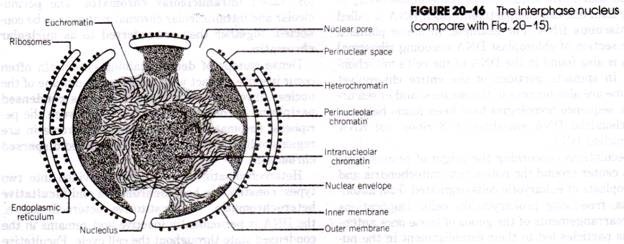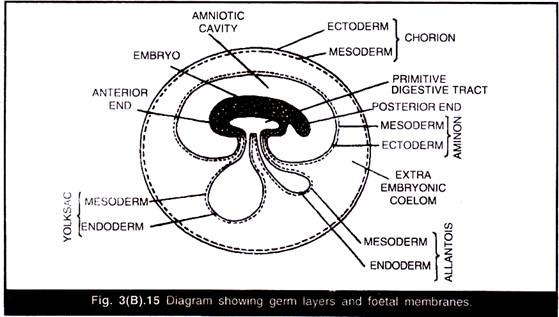Transformation of blastula or blastocyst into gastrula is called gastrulation. During gastrulation the cells of the inner cell mass of blastocyst or blastula move in small mass to their new final location.
Such movement of cells is called morphogenetic movements Gastrulation results in the formation of three germ layers: ectoderm, mesoderm and endoderm.
Each germ layer gives rise to specific tissues, organs and organ-systems.
The fate of the germ layers is the same in all triploblastic animals.
(i) Formation of Endoderm (Fig. 3(B).13):
The blastocyst grows in size by obtaining nutrition from the uterus. Some cells separate from the inner cell mass (embryonic knob) to form endoderm in blastocoel. The endoderm differentiates into the primitive gut; a part of it gives rise to alimentary canal and the other portion forms yolk sac. After the formation of endoderm, the remaining mass of cells of the inner cell mass forms embryonic disc. It has three parts: cephalic margin, embryonic disc proper and caudal margin.
 (ii) Formation of Mesoderm (Fig. 3(B). 14):
(ii) Formation of Mesoderm (Fig. 3(B). 14):
Mesoderm is formed from the caudal margin of the embryonic disc. Prior to this the existing cells undergo rapid division and a mass of cells detach from the embryonic disc to form mesoderm.
(iii) Formation of Ectoderm (Fig. 3(B). 14):
After the separation of mesoderm, the remaining cells of the embryonic disc form the ectoderm layer. In this manner the three germ layers such as ectoderm, mesoderm and endoderm are formed.
Fate of Three Germ Layers (Fig. 3(B). 15):
Each germ layer forms specific tissues, organs and organ-systems.
The three germ layers produce tissues, organs and organ-system in following manner:
1. Ectoderm:
It forms:
(i) Epidermis of skin, epidermal derivatives like epidermal glands, hair, nail etc.
(ii) Nervous system,
(iii) Medulla of adrenal gland, posterior and intermediate lobes of pituitary gland, pineal gland,
(iv) Eye (conjunctiva, cornea, lens, retina, iris and ciliary muscles),
(v) Internal ear,
(vi) Nasal and olfactory epithelia,
(vii) Enamel of teeth,
(viii) Epithelium of fore gut and hind gut
(ix) Some glands—sweat glands, oil glands, mammary glands, salivary glands and lacrimal glands.
2. Mesoderm:
It forms:
(i) Dermis of skin,
(ii) Muscles except iris and ciliary muscles,
(iii) Connective tissues,
(iv) Kidneys,
(v) Gonads,
(vi) Notochord,
(vii) Heart, blood and lymph vessels,
(viii) Urinary and reproductive ducts,
(ix) Most of skeleton,
(x) Coelomic epithelium,
(xi) Pericardium and pleura,
(xii) Dentine of teeth,
(xiii) Cortex of adrenal gland,
(xiv) Mesenteries,
(xv) Sclera and choroid of eyes,
(xvi) Wall of the gut except its lining.
3. Endoderm:
It gives rise to:
(i) Lining of gut except for gut and hind gut,
(ii) Some glands—pancreas, liver, gastric glands, intestinal glands, thyroid, parathyroid, thymus and larger part of prostate,
(iii) Inner layer of tympanic membrane,
(iv) Lining of middle ear,
(v) Trachea, bronchi and lungs,
(vi) Urinary bladder,

